





When choosing broadleaf evergreen shrubs for Southern landscapes, it is easy to fall back on the ones that we see in neighbors' yards and the ones that are commonly available. Every neighborhood is filled with azaleas, camellias, gardenias, loropetalums, and ligustrums. However, there are some less-commonly chosen evergreen shrubs that will add charm and distinction to your landscape.
Florida anise (Illicium floridanum) is one of the South's most dependable broad-leaved evergreen shrubs. Glossy but leathery dark green leaves 2 to 6 inches long and 1 to 2 inches wide adorn the tree year-round. A sniff of the leaves reveals a pleasant anise scent that tempts the passerby to tear a leaf in order to enjoy the spicy aroma.
In spring, maroon, 2-inch diameter flowers with many straplike petals bloom. While they are attractive enough for viewing, getting too close may reveal a somewhat fishy odor. Do not cut the offending blossoms, though, for the flowers give way to star-shaped, papery folicles that hold the BB-like seeds. When mature, the seeds burst and send the seeds in all directions. These seeds germinate readily and provide an easy means of propagation. New plants can also be obtained from mature or hardwood cuttings that root easily.
Expect Florida anise to grow from 10 to 15 feet tall and about 6 to 10 feet wide. Hardy from USDA Zones 7-10, it is an excellent choice gardens in the Deep South. Specimens can be found in the wild in the Florida panhandle and across Georgia, Alabama, and Mississippi to southeastern Louisiana. Common names include Florida anise, purple anise, stinkbush, and star anise.
Cultural Requirements
Plant Florida anise in shade to partial shade in well-drained, moist, acid soil. Soil high in organic matter is preferred. If your soil is either extremely sandy or clayey, adding organic matter to the entire area where the shrubs are to be planted will be beneficial. Fertilize in spring as growth begins with an all-purpose fertilizer and mulch well to maintain moisture and boost the organic content of the soil. Few pests attack this native shrub.
If desired, the shrub can be trained into a small tree by removing some of the lower limbs. For a more rounded, shrublike form, tip prune to encourage branching, especially when young. If a hedge is desired, plant on 10-foot centers for compactness. In a mixed shrub border, allow about 15 feet between Florida anise and other shrubs to maintain the individuality of each specimen. Florida anise fits well into naturalistic landscapes in damp, shady areas.
Kinds of Illicium
Cultivars of Illicium floridanum include the white-flowered form album, as well as cultivars like 'Semmes' and 'Alba'. Choose 'Halley's Comet' for darker flowers and an extended bloom time. For variety, select 'Shady Lady' for its variegated leaves and pink flowers. 'Pebblebrook' is a dwarf cultivar that grows to about 5 feet tall and wide.
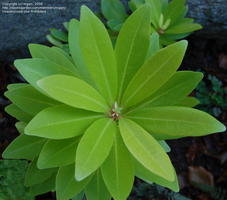 Yellow anise (Illicium parviflorum), another Florida native, is also very useful in the landscape. Size is perhaps a bit larger than Florida anise (15 to 20 feet tall), and it can tolerate more sun. Leaves are olive-green, especially when grown in sun, and small yellow flowers often go unnoticed. The growth habit is upright to pyramidal, and suckers often appear around established shrubs. The plant tolerates a wide variety of soils, from extremely moist to dry, and is tolerant of both sun and shade.
Yellow anise (Illicium parviflorum), another Florida native, is also very useful in the landscape. Size is perhaps a bit larger than Florida anise (15 to 20 feet tall), and it can tolerate more sun. Leaves are olive-green, especially when grown in sun, and small yellow flowers often go unnoticed. The growth habit is upright to pyramidal, and suckers often appear around established shrubs. The plant tolerates a wide variety of soils, from extremely moist to dry, and is tolerant of both sun and shade.
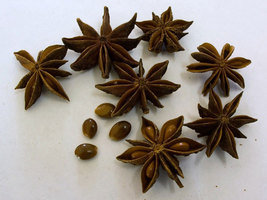 Yellow anise is easily rooted from cuttings, and it occurs naturally in wet areas in southern Georgia and Florida. Hardy in Zones 7-9, it is a vigorous and worthwhile plant where a broadleaf evergreen shrub or small tree is needed.
Yellow anise is easily rooted from cuttings, and it occurs naturally in wet areas in southern Georgia and Florida. Hardy in Zones 7-9, it is a vigorous and worthwhile plant where a broadleaf evergreen shrub or small tree is needed.
Do not use llicium floridanum or I. parviflorum as spices. Both are toxic and should not be ingested. The popular star-anise (Illicium verum) that is used as a culinary spice hails from China and Vietnam.
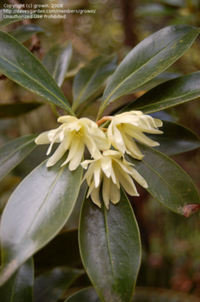 Japanese anise-tree (Illicium anisatum), which is native to China and Japan, is well-suited to gardens in USDA Zones 8 to 9. It makes a great evergreen shrub or small tree growing from 6 to 10 feet tall. Highly adaptable, this plant can be grown in full sun or in a mostly shaded location. Although it grows best in moist, well-drained, rich soil, it is moderately drought tolerant and requires little fertilizer for good foliage color and adequate growth. Fruits are extremely toxic. Suckering does not seem to be a problem with this species.
Japanese anise-tree (Illicium anisatum), which is native to China and Japan, is well-suited to gardens in USDA Zones 8 to 9. It makes a great evergreen shrub or small tree growing from 6 to 10 feet tall. Highly adaptable, this plant can be grown in full sun or in a mostly shaded location. Although it grows best in moist, well-drained, rich soil, it is moderately drought tolerant and requires little fertilizer for good foliage color and adequate growth. Fruits are extremely toxic. Suckering does not seem to be a problem with this species.
Very rare and seldom encountered in the trade are three other species. Mexican anise-tree (Illicium mexicanum) hails from Mexico, and Henry anise-tree (Illicium henryi) comes to us from western China. Rarer still is Illicium simonsii, a Chinese species that bears pale yellow flowers. Perhaps one day these uncommon species will become more available.
Regardless of the species or cultivar of Illicium that you choose for your garden, one of them will surely be a good addition. In time it may become one of your all-time favorites. Remember that it is not necessary to choose the same evergreen shrub that your neighbors have. Branch out and add uncommon beauty to your garden with Florida anise or any other of the anise shrubs.
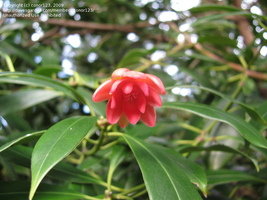
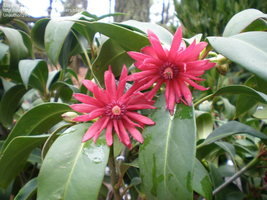
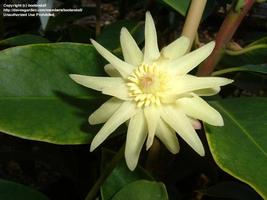 AT A GLANCE
AT A GLANCE
Common names: Florida anise, purple anise, stinkbush, star anise
Scientific name: Illicium floridanum
Pronunciation: il-LISS-ee-um flor-ih-DAY-num
Family: Illiciaceae (Illicium)
Origin: Florida panhandle to southeastern Louisiana
Size: 10-15 ft. tall/6-10 ft. wide
Hardiness: USDA Zones 7-10
Salt tolerance: Slight
Other species: Illicium verum (star anise); I. parviflorum (yellow anise), I. mexicanum (Mexican anise-tree), I. henryi (Henry anise-tree), I simonsii, I. anisatum
Propagation: Cuttings; seeds
Thanks to bootandall, conor 123, growin, plantfreak, and mgarr for pictures used in this article. Mouse over each picture for identification.
All other pictures are by the author.
For more reading:
USDA PLANTS Profile for Illicium floridanum
Illicium parviflorum in Floridata
Wikipedia article on Illicium verum
University of Florida factsheet on Illicium anisatum
Illicium simonsii at Quarryhill Botanical garden
Copyright © www.100flowers.win Botanic Garden All Rights Reserved